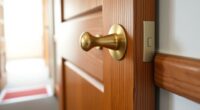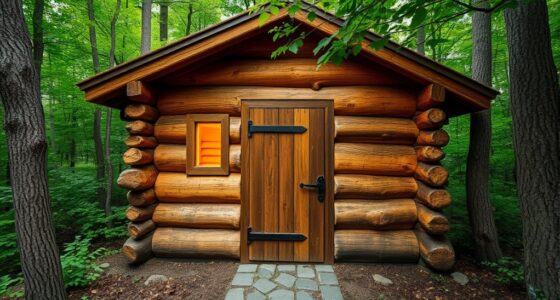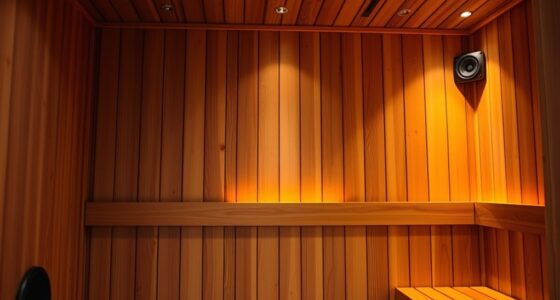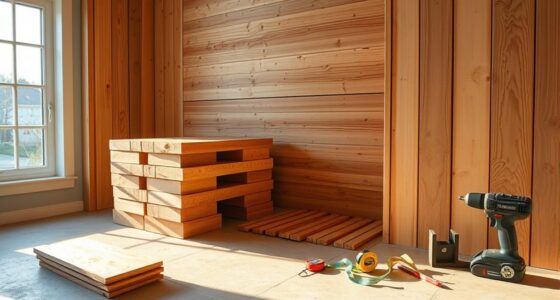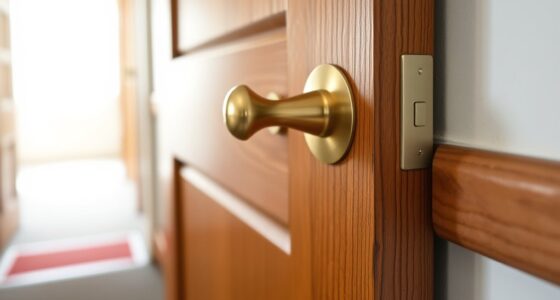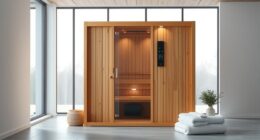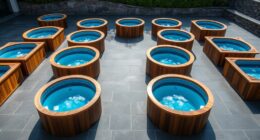To waterproof your indoor sauna, install vapor barriers like foil-faced insulation beneath wall coverings and floors. Use waterproof membranes under tiles or stone, and make certain floors are sloped toward drains for efficient water removal. Incorporate drainage solutions such as recessed, flush grates and regularly maintain them to prevent clogs. Proper ventilation also helps control humidity and moisture buildup. Keeping these strategies in mind will help you protect your sauna from water damage—plus, you’ll discover more tips as you continue.
Key Takeaways
- Install vapor barriers beneath finishing materials like tiles or paneling to prevent moisture infiltration into structural components.
- Use waterproof membranes and sealant joints to protect walls, floors, and ceilings from water penetration.
- Incorporate sloped flooring with drains and recessed grates to direct water away efficiently and facilitate cleaning.
- Ensure proper ventilation with exhaust fans or vents to remove excess humidity and reduce condensation buildup.
- Regularly maintain drainage systems and inspect seals to prevent clogs, leaks, and moisture accumulation inside the sauna.
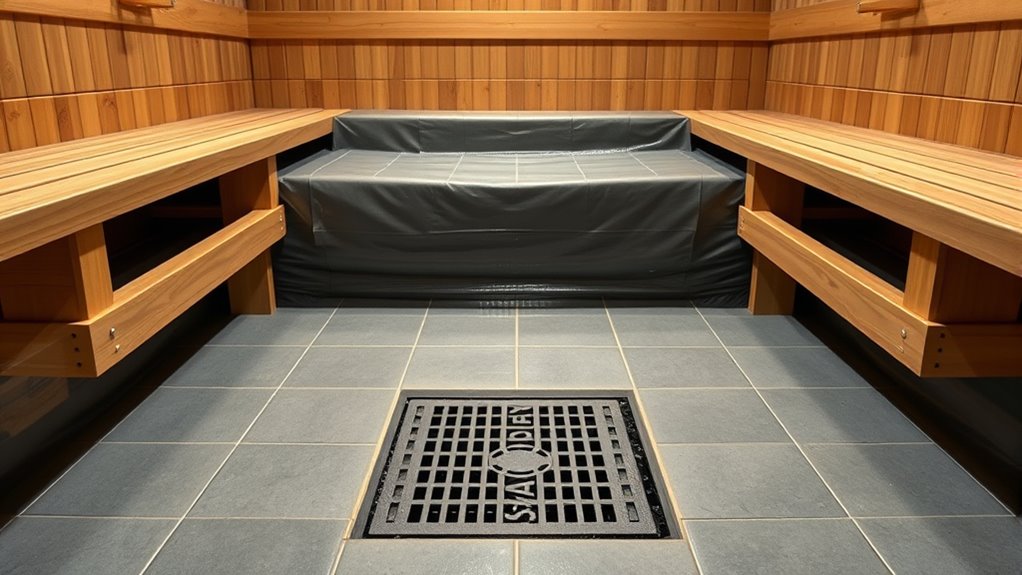
Creating a comfortable and safe indoor sauna requires effective waterproofing and drainage solutions. Without proper moisture management, you risk damaging your space, developing mold, or creating an unhealthy environment. One of the key steps is controlling humidity levels to prevent excess moisture from lingering on surfaces and in the air. When humidity gets too high, it can lead to wood warping, deterioration of insulation, and potential health hazards. To combat this, you need to implement reliable vapor barriers that prevent moisture from seeping into walls and floors. Vapor barriers act as a shield, blocking moisture from penetrating building materials and ensuring that water vapor stays contained within the sauna’s interior. Installing high-quality vapor barriers on walls, ceilings, and floors is essential for maintaining a dry environment and prolonging the life of your sauna.
Proper placement of vapor barriers is vital. You should lay them underneath the finishing materials, such as tiles or paneling, to create a continuous moisture-resistant layer. This prevents vapor from rising into insulation or structural components, which could lead to mold growth or rot. Additionally, choosing vapor barriers made from durable materials like polyethylene or foil-faced products enhances their effectiveness and longevity. Along with vapor barriers, you should pay attention to ventilation and airflow. Good ventilation helps regulate humidity by removing excess moisture and bringing in fresh air, reducing the chance of condensation forming on surfaces. An exhaust fan or vent near the ceiling can considerably improve humidity control, especially during and after sauna sessions. Incorporating proper moisture control strategies is crucial to maintaining a healthy indoor environment over time.
Drainage solutions are equally important in keeping your sauna dry and safe. Installing a proper drainage system ensures that any water, whether from steam, spills, or cleaning, drains away efficiently. Sloping floors toward a drain prevents water from pooling, which can cause slipping hazards and damage to flooring materials. Waterproof membranes beneath tiles or stone surfaces further protect underlying structures from water infiltration. Consider integrating a recessed drain with a grate that’s flush with the floor surface, making cleaning easier and minimizing trip hazards. Regular maintenance of these drainage systems prevents clogging and ensures continuous water flow.
Frequently Asked Questions
How Often Should I Inspect Sauna Waterproofing for Damage?
You should inspect your sauna’s waterproofing at least every six months to catch any damage early. Regular inspection helps in damage prevention, ensuring moisture doesn’t seep in and cause issues. After heavy use or if you notice any leaks or mold, check more frequently. Staying vigilant with your inspection schedule keeps your sauna safe, extends its lifespan, and maintains a healthy environment. Don’t wait for visible damage—prevent it with regular checks.
Can I Waterproof a Sauna Without Professional Help?
You can tackle DIY waterproofing for your sauna, but keep in mind, studies show that improper sealing can lead to costly damage over time. If you’re comfortable with basic home repairs, you can apply waterproof sealants and check drainage systems yourself. Regular sauna maintenance is key to preventing issues. However, for best results and long-term durability, consulting a professional is often the safest choice, especially for complex waterproofing needs.
What Are the Signs of Drainage System Failure in a Sauna?
If you notice water pooling or persistent damp spots in your sauna, it’s a clear sign of drainage issues. You might also see mold, unpleasant odors, or warped flooring, indicating the drainage system’s failure. These problems can lead to water damage and mold growth if left unaddressed. Regularly inspect for standing water and pooling, and fix any drainage problems promptly to keep your sauna safe and dry.
Are Eco-Friendly Waterproofing Options Available for Saunas?
Are eco-friendly waterproofing options available for your sauna? Absolutely! You can opt for eco-friendly sealants made from sustainable materials that protect without harming the environment. These products are designed to be non-toxic, low VOC, and biodegradable, ensuring your sauna remains safe and eco-conscious. Isn’t it great to enjoy relaxation while also caring for the planet? Choosing these sustainable solutions helps reduce your ecological footprint effortlessly.
How Does Humidity Affect Sauna Waterproofing Longevity?
Humidity effects can considerably impact your sauna’s waterproofing lifespan. When humidity levels are high, moisture can seep into the waterproofing materials, causing them to deteriorate faster over time. You should ensure proper ventilation and choose high-quality, moisture-resistant waterproofing solutions to mitigate these effects. Regular maintenance and inspections help prolong the waterproofing lifespan, preventing costly repairs and keeping your sauna safe and dry for years to come.
Conclusion
With the right waterproofing and drainage, your indoor sauna becomes a sanctuary of warmth and tranquility, free from puddles and moisture worries. Imagine stepping inside, knowing every surface is protected like a gentle shield, guiding water seamlessly away to keep the air dry and inviting. When you invest in these solutions, you create a space where steam rises effortlessly, and relaxation flows endlessly—turning your sauna into a peaceful retreat that stands resilient through every session.

